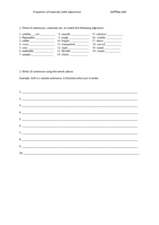Curated OER
A Solubility Curve for Potassium Nitrate
Step-by-step laboratory instructions are listed so that chemistry explorers can consider the solubility of potassium nitrate. They combine their results with those of other lab groups and then graph the data to display the solubility...
Fuse School
Quiz: Diffusion and Solubility Curves
Quiz time! Part eight in a 14-part series about solids, liquids, and gases provides an opportunity to assess individual's learning. The interactive quiz covers the topics of solubility, solubility curves, and diffusion.
Curated OER
Solubility Curves
In this solubility curve learning exercise, students are given a solubility curve for a variety of compounds and they answer 17 questions about the solubility of the compounds shown.
Curated OER
Solubility Curves
In this solubility activity, students use a solubility curve to determine is different solutions are saturated or not. This activity has 19 problems to solve and 2 short answer questions.
Nuffield Foundation
Making a Calibration Curve for Starch Concentration
How well can your class concentrate on solutions? Scholars use colorimeter absorption to explore a starch concentration calibration curve. They add iodine to different starch solutions to see how the concentration of the solution changes.
Chemistry Collective
Virtual Lab: Determining the Solubility Product
No chemistry lab? No problem! Scholars use a virtual lab to determine the solubility product of four different chemicals. They then use the results of their experiments to see if higher solubility product values equal greater solubility.
Curated OER
Solutions Review
For this solutions worksheet, students review the properties of solutions, the polarity of molecules, molarity, and solubility curves. This worksheet has 8 short answer questions and 15 problems to solve.
Curated OER
Organic Chemistry 231, Martin Larter, Exam 1
If you need a straightforward and comprehensive organic chemistry exam, check this one out. Chemistry pupils identify functional groups in molecule diagrams, draw a Lewis structure, fill in a table about molecular shape, predict boiling...
Curated OER
2009 U.S. National Chemistry Olympiad National Exam - Part I
The 2009 version of the first part of a national chemistry competition is posted for your use with olympiad hopefuls. Test takers deal with 60 multiple choice questions covering an entire year of chemistry curriculum. Use this to...
Curated OER
Equilibrium Practice Problems
In this equilibrium worksheet, students answer thirty multiple choice problems including topics such as pH, analyzing titration curves, calculating molar concentrations and working with equilibrium constants.
Curated OER
Solutions Test Review
In this solutions worksheet, students review the most commonly used solvent, give examples of an emulsifying agents and alloys, and use solubility curves to answer questions. This worksheet has 11 fill in the blank, 6 short answer, and...
Curated OER
Chapter 15 Review, Section 2: Acid-Base Titration and pH
Keep it simple with this chemistry assignment. Learners examine an acid-base titration graph and answer four questions about the data. Then they will balance neutralization equations and calculate molarity for several specific solutions....
Normal Community High School
Golf Ball Lab
The first golf balls were made of wood and would only last for a few games. Modern golf balls last a lot longer but they don't float. The presentation provides the directions for a lab to determine the minimum amount of salt needed to...
Curated OER
Properties of Materials (with adjectives)
Help your students write descriptive lab reports! Designed for ESL students but useful for mainstreamed kids as well, the activity prompts students to think of substances that match twenty given adjectives ("salt" for "soluble," for...
Curated OER
Acid Base
In this acid and base worksheet, students review the characteristics of acids and bases, how to calculate pH of a solution, and define a buffered solution. This worksheet has 16 multiple choice questions and 3 problems to solve.
Curated OER
Mixture Mayhem
In this mixture worksheet, students are given five mixtures and they determine if each is a mechanical mixture or a solution. They also identify the way each substance within the mixture can be separated from the others.
Curated OER
Tank Trials - Measuring Germination
Students observe and measure seed germination. In this life science lesson, students use 'tanks' to observe a set of seeds as they germinate and begin growing, make predictions, and record their data. Lesson includes background teacher...
Curated OER
Protein Assays: Bio Rad and Page Gels
Students conduct the Biuret Test and the Bio Rad Protein Assay. They examine the spectrophotometer and graph molecular weights and the concentrations of the proteins investigated. They prepare solutions for the Bio-Rad test and use the...
Curated OER
Teaching about Increased Conductivity: Are Culverts The Culprits?
High schoolers encounter the complexity of identifying the cause of unusual variations in WOW conductivity data. They propose theories on why there was a sudden increase in conductivity in Ice Lake, Minnesota during July of 1998.
Curated OER
Easy Printmaking in the Classroom
Students use styrofoam and cardboard to create prints. Students choose a theme and create designs and pictures on styrofoam and cardboard. Students also use construction paper, cardboard cylinder sections to make their art.
Other popular searches
- Using Solubility Curves
- Reading Solubility Curves
- Sucrose Solubility Curves
- Succrose Solubility Curves
- Sugar Solubility Curves
- Worksheets Solubility Curves





















